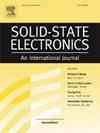用于射频波段 III-V/Si 单片 3D 电路的硅基集成无源器件堆栈
IF 1.4
4区 物理与天体物理
Q3 ENGINEERING, ELECTRICAL & ELECTRONIC
引用次数: 0
摘要
在这项研究中,我们展示了一种基于硅(Si)的集成无源器件(IPD)堆栈,用于支持在射频(RF)频段工作的 III-V/Si 单片 3D (M3D) 集成电路。该 IPD 堆栈基于 8 英寸 CMOS 工艺线制造,并通过 M3D 与 InGaAs HEMT 层集成。为了同时最大限度地降低射频损耗和晶圆弯曲,在 IPD 中建立了富阱层和埋入氧化层的工艺条件。通过该工艺条件,共面波导在 30 GHz 时的射频损耗为 -0.631 dB/mm,低于 CMOS 代工厂的水平,而叠层的晶圆弯曲则低至 -5.5 μm。与迄今报道的在射频频段工作的其他基于 CMOS 代工工艺的电感器相比,电感器的最大品质因数显示出良好的数值。为了获得 IPD 叠层的压缩轮廓(这是将 III-V 有源层推进到晶圆到晶圆级 3D 粘合的最重要要求之一),开发了一种用于 IPD 最后 IMD 层的工艺方法,从而使 IPD 从拉伸轮廓变为压缩轮廓(相应的晶圆弯曲值从 -12.6 μm 到 +10.7 μm)。本文章由计算机程序翻译,如有差异,请以英文原文为准。
Silicon-based integrated passive device stack for III-V/Si monolithic 3D circuits operating on RF band
In this study, we demonstrated a silicon (Si)-based integrated passive device (IPD) stack to support III-V/Si monolithic 3D (M3D) ICs operating on the radio frequency (RF) band. The IPD stack was fabricated based on an 8-inch CMOS process line and integrated via M3D with an InGaAs HEMT layer. A process condition for a trap rich layer and a buried oxide layer in the IPD was established to simultaneously minimizing both the RF loss and wafer bowing. Through the process condition, the RF loss of the coplanar waveguides was −0.631 dB/mm at 30 GHz, lower than that of the CMOS foundry, and the wafer bowing of the stack was as low as −5.5 μm. The maximum quality factor of the inductors showed good values when compared to those of other CMOS foundry process-based inductors operating on the RF bands reported thus far. To obtain a compressive profile for the IPD stack, which is one of the most important requirements in advancing to wafer-to-wafer-level 3D bonding with the III-V active layer, a process method for the final IMD layer of the IPD was developed, resulting in a change from a tensile profile to a compressive profile for the IPD (corresponding wafer bowing value from −12.6 to + 10.7 μm).
求助全文
通过发布文献求助,成功后即可免费获取论文全文。
去求助
来源期刊

Solid-state Electronics
物理-工程:电子与电气
CiteScore
3.00
自引率
5.90%
发文量
212
审稿时长
3 months
期刊介绍:
It is the aim of this journal to bring together in one publication outstanding papers reporting new and original work in the following areas: (1) applications of solid-state physics and technology to electronics and optoelectronics, including theory and device design; (2) optical, electrical, morphological characterization techniques and parameter extraction of devices; (3) fabrication of semiconductor devices, and also device-related materials growth, measurement and evaluation; (4) the physics and modeling of submicron and nanoscale microelectronic and optoelectronic devices, including processing, measurement, and performance evaluation; (5) applications of numerical methods to the modeling and simulation of solid-state devices and processes; and (6) nanoscale electronic and optoelectronic devices, photovoltaics, sensors, and MEMS based on semiconductor and alternative electronic materials; (7) synthesis and electrooptical properties of materials for novel devices.
 求助内容:
求助内容: 应助结果提醒方式:
应助结果提醒方式:


